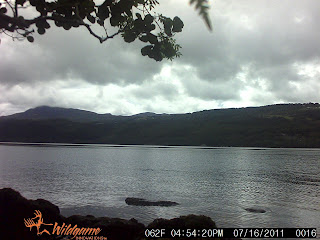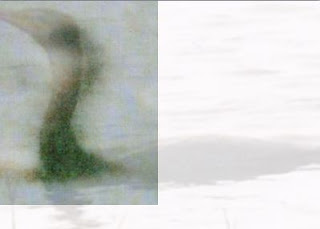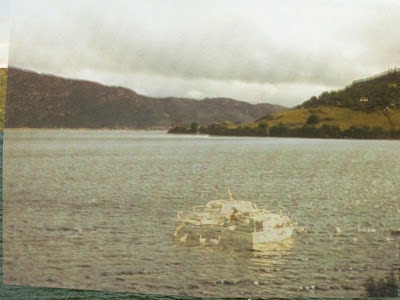It was on the 18th July 2010 that I published my first
article on this blog. It wasn't much, basically a "
Welcome to the Loch Ness Blog" post which flagged my intentions and nothing more. At the time, I had no idea whether it would have any impact on people's perceptions of the Loch Ness Monster and even to this day, I find such a metric hard to quantify.
Be that as it may, the blog has increased in popularity as people seeking old and new information on Nessie make their visits. That first post currently has a modest page hit of 509. The most popular posting to date is Marcus Atkinson's
sonar story with over 81,000 hits. Behind that lies one of my favourites -
the analysis of the Hugh Gray photograph.
In terms of search engines, a Google search for "
loch ness monster" usually finds the blog somewhere on the first page of results which has some relevance as not every Google user goes beyond the first page.
Again, this helps gets the message out as people do not know exactly where to find the material. Nevertheless, what people think of what they read no doubt covers a wide spectrum! One thing is certain, though. If people are not reading it, they are not being affected by it. Those reading it may have ascertained the ethos of the blog. It is to defend the Loch Ness Monster and attack opposition arguments.
That may sound a tad bellicose, but it is an argument rather than a war. It is based on words rather than weapons. It is a strategy that uses the same tools that sceptical commentators claim to use. Indeed, some sceptics reading this may smirk and assure themselves that they have exclusive access to these tools, but I disagree.
Over these three years, I have gotten used to various remarks ascribed by sceptics to those who believe in the existence of large, unknown animals in Loch Ness. They're now like water off a plesiosaur's back. However, that does not diminish the motivation to state one's own case.
There will be phrases such as "
gullible", not "
grown up" or indulging in the equivalent of reading entrails. Meanwhile, eyewitness reports are sarcastically demoted to "
ancient texts" as if they had as much relevance to life today as the
Epic of Gilgamesh.
Such is the attitude of some sceptics to those who believe or know there is a monster in Loch Ness. Such is the hardening of scepticism towards opposing views over the last quarter of a century as they began to dominate the game.
Scepticism applies science and critical thinking whilst we seemingly apply the throwing of
juju bones. As I have surveyed and analysed the so called application of science and logic by scepticism, I sometimes wonder if the roles are better reversed.
There is no better example than the
recent claim by an Italian scientist that Loch Ness Monster sightings are attributable to earthquakes along the Great Glen fault. It is a ridiculous claim that is easily refuted but since it is a scientist that proclaims it and since some thinking must have been involved, then surely we ought to genuflect before it?
Then there was the
claim in 2006 by paleontologist, Neil Clark, that some sightings were attributable to circus elephants swimming in Loch Ness. Not as daft as earthquake bubbles but one that is again not backed up by the evidence. Again, do we swallow this explanation hook, line and sinker because it came from someone who claimed to apply the scientific method?
Going back to the 1960s, we had eminent zoologist, Maurice Burton, extolling the virtues of vegetable mats floating around Loch Ness. No one now believes this has any logical force or evidential compulsion.
So much for scientists you may say, but sceptics sidestep these issues by claiming that these theories are postulated by scientists who may be expert in one field, but not in others relevant to Loch Ness. Which prompts me to ask whether they themselves are qualified in the fields they speak on. What do I mean by that?
Today, Loch Ness Monster sightings are dismissed on the premise that they are ordinary objects seen in out-of-ordinary circumstances. So it is not seismic bubbles, elephants or rotting mats but just a log or a boat wake or a string of birds seen in the wrong place at the wrong time.
By way of example, over on the
Loch Ness Monster Debate Facebook page, one researcher told all and sundry that the famous Greta Finlay
case was merely a sighting of a deer and a boat wake. When that monstrous explanation surfaced, even fellow sceptics did not accept it:
"I
think skeptics claiming what the Finlay's saw was a Deer is a bit of an
insult to their intelligence really as I'm sure being resident in the
area, they would have seen the odd one every now and again!"
"I
find the "deer debunk" a little bit of a stretch myself, anyone with
even minimal experience in the outdoors can identify a deer."
I agree with them, it does not make sense and if I was a sceptic it would be more logical just to call it a hoax. But having read the claims of scepticism these last three years, it became evident that there was one theory that was being promoted which to me has about as much kudos as bubbles and pachyderms.
It is the theory that people entering the Loch Ness Zone, come under some psychological change that makes them see monsters instead of deers and other objects. We are not talking about people who make honest mistakes about standing waves half a mile away. This apparently covers even sightings only 20 yards away!
Remember I talked about those not qualified to speak? Well, if you are going to talk about gross misperceptions, I suspect you need to be qualified in matter of neurology as it appertains to the visual, perceptual and memory portions of the brain. I don't think I have met such a person in the field of Loch Ness research yet, but the implication is that there exists a rigorous scientific framework for this.
I don't see any such books, experiments or peer reviewed scientific papers which compel anyone to accept that Nessie sightings can be explained in this way. There has been experiments with poles bobbing up and down in the water, but nothing conclusive. The theory does not even appear to be falsifiable (i.e. it always comes up with an explanation). If anyone says that all sightings can be explained in such a way (apart from the ones they decide are hoaxes), ask them for scientific proof.
But the "battle" continues apace. I noted this article with the bold title "It’s time to finally give up on the Loch Ness Monster". Really? Tell me why!
For a start we are swiftly directed to a recent
blog piece on Scientific American by Darren Naish who has rehashed an analysis of various Nessie photos. Let us see how cutting a piece of critical thinking it is. Well, for a start, it is not Mr. Naish's own critical thinking as most sceptics just regurgitate what others have said. As it turns out, his article has more logical holes in it than the proverbial Swiss cheese.
For a start, he tells us that:
"sightings and photographic and sonar evidence can be satisfactorily
explained as mistaken or embellished encounters with known animals
(including swimming deer, water birds, seals, and small cetaceans),
waves, or optical illusions."
However, and in the light of what I just said, he prefaces that statement with the words "
I am of the opinion that ...". In other words, this is no scientific fact that he is presenting, it is just his opinion. Why is that? Because he can't prove it!
He further says:
"The expectation that there’s an unknown animal in Loch Ness almost certainly explains the recent history of sightings."
There's that unproven theory again but now he tells us it is a near certainty it is true without any evidence to conclusively prove it. But crucial to that theory is the absence of monster reports before monster fever struck in 1933:
".. there is no tradition of sightings, nor are their old historical reports or anything like that pre-dating the 1930s"
This is complete nonsense, and I have devoted an entire
book to disproving it. But if people were claiming to see Nessie before 1933, his theory about modern monster expectations takes a serious blow.
Naish then proceeds through some well known hoaxes such as the Wilson and Shiels photographs. He then calls fake on the famous picture of Nessie approaching Castle Urquhart by Peter MacNab. He claims it is too big and too dark but claims the real bad news was Roy Mackal's analysis in 1976. That analysis was shown to be irrelevant in my own
article on the picture. Darren should have had no problem finding the article, you type "
peter macnab loch ness" into Google and it comes up as top match. But why let the facts get in the way of a good story?
Darren's debunking of Peter O' Connor's picture is then executed but again he is almost completely reliant on what others have said (in this case, Maurice Burton). Did Naish critique Burton's analysis? You can bet your ass he didn't and therein lies a problem. Sceptics do not critique sceptics in any meaningful degree. Never mind, that's my job .. .and anyone else that cares to join me.
Then the Rines photos and the recent Edwards picture are shot down and with some reason I have to agree. But what about the other pictures? Has Darren committed a logical non-sequiter by making his readers assume that if these are fakes then so are the rest? Yes, he has.
So, with that, he says, "
So that's that! We move on." I wish they would and leave Loch Ness to the rest of us (and
Charlie Sheen)!
Three years on, the modus operandi of scepticism has become more familiar to me. In fact, as one reader suggested, it can be perceived as more than a scientific norm, it is a social and cultural norm. In other words, it is fashionable to be a sceptic. Laissez faire principles apply as supply and demand produces more sceptics and we reach saturation point. You can't move for them now on cryptozoological forums! Back in the 60s and 70s, I suspect the situation was the complete opposite - again because it was more fashionable to believe in high strangeness.
But to be fashionable leads to lack of competition, which leads to lack of peer review and leads to obesity in critical thinking which leads to ill thought out arguments which more often than not are proposed rather than proven.
Will scepticism accept any of this? Of course it won't. Will this blog continue to find the flaws in their arguments? All I can say is, here's to another three years!













.JPG)



















